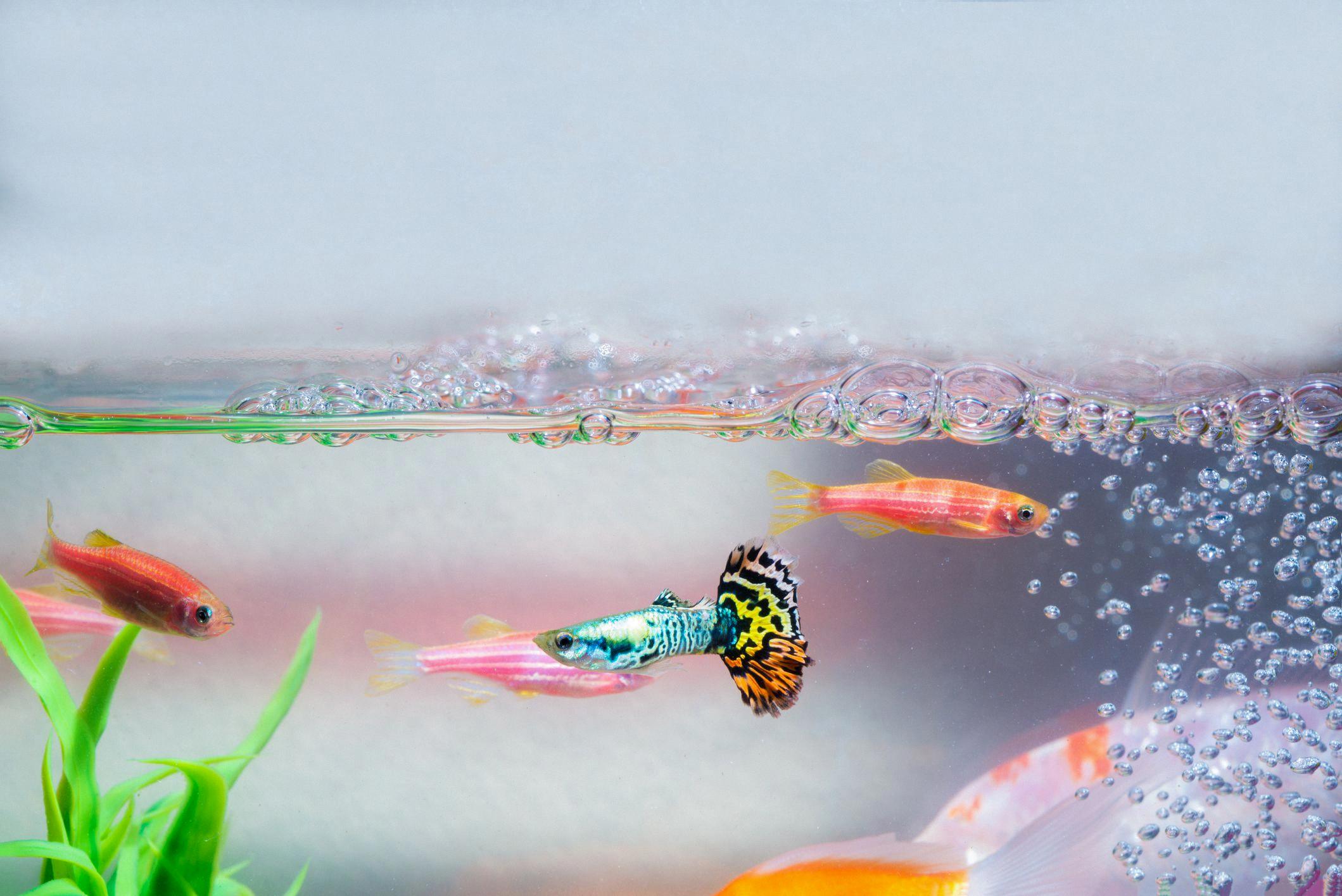Guppies are a popular choice among aquarium enthusiasts due to their vibrant colors and lively personalities. If you are considering adding guppies to your tank, it is important to create a suitable environment for them to thrive. One aspect to consider is the water flow or current in the tank.
In their natural habitat, guppies inhabit slow-moving or stagnant waters such as streams, ponds, and rice paddies. They are not particularly adapted to strong currents like some other fish species. Therefore, it is generally recommended to provide a gentle water flow in the aquarium to mimic their natural environment.
Excessive water flow can cause stress to guppies and may negatively impact their overall health and behavior. Strong currents can make it difficult for them to swim and navigate comfortably, leading to increased stress levels. This can result in decreased activity, loss of appetite, and even illness.
To create an ideal water flow for guppies, consider using a low-flow filter or an air-driven sponge filter. These types of filters provide gentle circulation and help maintain water quality while minimizing the water flow. Additionally, you can position the outlet of the filter to direct the flow away from areas where guppies prefer to swim or rest.
It is also important to note that guppies are surface dwellers and prefer to spend most of their time near the top of the tank. They have a unique ability to breathe air and often come to the water surface to take in oxygen. Therefore, it is essential to ensure that the water surface remains calm and undisturbed. Avoid creating strong surface agitation or using equipment that causes excessive splashing.
In addition to the water flow, it is crucial to maintain optimal water parameters for guppies. They prefer a pH level between 7.0 and 8.0 and thrive in slightly hard water with adequate levels of calcium and magnesium. Regular water testing and appropriate adjustments should be made to provide the best conditions for your guppies.
Ultimately, each guppy may have its own preferences when it comes to water flow. Observing their behavior and well-being will help you determine if the current in your tank is suitable. If you notice signs of stress or discomfort, such as erratic swimming or hiding behavior, it may be necessary to adjust the water flow to create a more peaceful environment.
Guppies do not particularly enjoy strong currents and thrive in gentle water flow. It is essential to provide a calm and undisturbed water surface for their surface-dwelling nature. By understanding and meeting their specific needs, you can ensure that your guppies will live a happy and healthy life in your aquarium.
What Do Guppies Like In Their Tank?
Guppies have specific preferences when it comes to their tank environment. Here is a detailed breakdown of what guppies like in their tank:
1. Water temperature: Guppies are tropical fish and thrive in water temperatures ranging from 72°F to 82°F (22°C to 28°C). It is important to maintain a stable temperature within this range to ensure their health and well-being.
2. pH level: Guppies prefer a slightly alkaline environment with a pH level ranging from 7.0 to 8.0. It is important to regularly test the pH level and make any necessary adjustments to keep it within this range.
3. Water hardness: Guppies prefer hard water with a moderate to high level of minerals such as calcium and magnesium. Hard water helps support their growth and overall health. You can test the water hardness using a water test kit and adjust it if necessary using products specifically designed for adjusting water hardness.
4. Filtration: Proper filtration is essential in guppy tanks to maintain water quality. A good filtration system helps remove toxins, waste, and excess food, keeping the water clean and healthy for the guppies. A combination of mechanical, chemical, and biological filtration is recommended for optimal results.
5. Lighting: Guppies are generally not picky when it comes to lighting, but they do require a regular day-night cycle. It is recommended to provide a light source for 8-12 hours a day to mimic their natural environment.
6. Plants and hiding spots: Guppies feel more secure and comfortable when they have plenty of plants and hiding spots in their tank. Live plants, such as Java moss or Amazon sword, provide not only hiding places but also help maintain water quality by absorbing excess nutrients.
7. Space and tank size: Guppies are active swimmers and appreciate having ample space to explore. A tank size of at least 10 gallons is recommended for a small group of guppies. However, the more space you can provide, the better it is for their overall well-being.
8. Water quality and maintenance: Regular water changes are crucial to maintain good water quality for guppies. Aim for weekly water changes of around 20-30% to keep ammonia, nitrites, and nitrates at safe levels. Use a water conditioner to remove chlorine and other harmful chemicals from tap water before adding it to the tank.
By providing guppies with the appropriate water temperature, pH level, water hardness, filtration, lighting, plants, hiding spots, and regular maintenance, you can create a suitable and thriving environment for these beautiful fish.

What Makes Guppies Happy?
Guppies are happiest when their environment meets their basic needs and provides them with stimulation and comfort. Here are some factors that contribute to the happiness of guppies:
1. Proper water conditions: Guppies thrive in clean and well-maintained water. Maintain a stable temperature between 75-82°F (24-28°C) and pH between 6.8-7.8. Regularly test and adjust water parameters to ensure optimal conditions.
2. Sufficient space: Guppies are active swimmers and require enough space to swim freely. Provide a tank with a minimum of 2.5 gallons (10 liters) per guppy, but a larger tank is always better.
3. Suitable tank mates: Guppies are social fish and enjoy the company of their own kind. Keep them in groups of at least five to six individuals. Avoid aggressive or fin-nipping tank mates that may cause stress or harm to the guppies.
4. Varied diet: Offer a balanced diet consisting of high-quality flake or pellet food specifically formulated for guppies. Supplement their diet with occasional treats like frozen or live foods such as bloodworms or brine shrimp to provide added nutrition and enrichment.
5. Regular feeding schedule: Feed guppies small portions two to three times a day. Overfeeding can lead to obesity and other health issues, while underfeeding can cause stress and malnourishment.
6. Provide hiding spots: Hiding spots, like caves, tubes, logs, and plants, give guppies somewhere to rest and relax. Ensure there are enough hiding spots for all the fish in the tank. The best plants for beginners are Java Ferns and Anubias. Only put aquarium-safe decorations in the tank.
7. Maintain good water quality: Regularly clean the tank, remove any uneaten food, and perform partial water changes to keep the water clean and free from harmful substances.
8. Stimulating environment: Guppies enjoy an enriched environment with plants, rocks, and other decorations that provide hiding spots, resting places, and areas to explore. This helps reduce stress and promotes natural behavior.
9. Proper lighting: Provide a suitable lighting schedule for your guppies. Aim for 10-12 hours of light per day, simulating a natural day-night cycle. Use a timer to automate the lighting schedule.
10. Avoid sudden changes: Guppies are sensitive to sudden changes in water conditions. When performing water changes or introducing new fish, make sure to acclimate them slowly to minimize stress.
By addressing these factors, you can create an environment that promotes the happiness and well-being of your guppies. Remember to observe their behavior regularly and make adjustments as needed to ensure their optimal health and happiness.
Where Do Guppies Swim In The Tank?
Guppies, being top water fish, primarily swim near the surface of the tank. They have a strong inclination to stay at the top of the water, as this is their natural habitat. While they may explore different areas of the tank, they tend to gravitate towards the uppermost region. This behavior is typical and can be observed consistently in guppies. They may occasionally venture to lower levels of the tank, but their preference is to remain near the surface.
The top water swimming pattern of guppies is influenced by their physiological characteristics and instincts. It is important to note that guppies possess a specialized organ called the labyrinth organ, which allows them to breathe air from the water’s surface. This unique adaptation enables guppies to survive in oxygen-deficient environments, but also encourages them to spend more time at the top of the tank.
To summarize, guppies are top water fish that exhibit a strong affinity for swimming near the surface of the tank. Their natural inclination and physiological adaptations make them predisposed to spend the majority of their time in the uppermost region of the water.
Conclusion
Guppies do enjoy some amount of water current in their tanks. While they are primarily top water swimmers, they still benefit from a gentle and consistent flow of water. The presence of current helps to simulate their natural habitat and provides them with exercise as they swim against it. However, it is important to note that excessive or strong currents can be detrimental to guppies, causing stress and exhaustion. Therefore, it is crucial to strike a balance and ensure that the current is not too strong for these delicate fish. By providing an appropriate level of water current, along with the right water conditions and hiding spots, guppy owners can create an ideal environment for their beloved fish to thrive and flourish.












